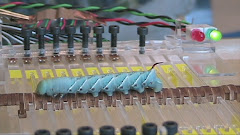Well, this August when I came back from the UK, I was compelled to consider replicating this biological feat with my robot. It was the week right after I developed a gait for my caterpillar robot to crawl through a 1cm hole all by itself. The Tufts robotic team was concerned with meeting the DARPA speed metric. Crawling gaits are robust, but rather slow in general. To defended my love of biological inspirations, I introduced this more dramatic locomotor mode. A few days later I had lunch with two of my best colleagues again at WholeFood, it came across our minds that it might not be too crazy to replicate what the rolling caterpillar has done. So the idea of "GoQBot" came into being, but it took us another month of hard work to translate what's on a napkin blueprints to a physical entity (yes, the original ideas were outlined on two WholeFood napkins).
Why is it called "GoQBot"? That's another interesting story. My buddy Tim is really good at drawing comics around engineering schematics. He was also one of the two colleagues in that brainstorming lunch break, the other being Dr. Gary Leisk. Tim envisioned this robot being so quick that it will go on and on as it rolls. So he drew a robot rider who shouted "GoGoGo". Gary later interpreted that into Go to the cubic power like "G^3". I thought the name could be a little more sexy and turned it into "Go-Q". The letter "Q" pictorially resembles the configuration when the caterpillar rolls into shape, and phonetically retained the cubic power of Go. Interestingly, the first generation of GoQ-Bot literally rolled three rotations (Go^3) in the Q configuration. See the brief introduction below!
"GoQBot-I" retains the same body plan from the InchBot series (InchBot IV~VII) which could performed three kinds of inching gaits, two variations of crawling gaits and a spacial climbing gait. This time, the robot has two additional flexible tail appendages that provided stability and guided curling trajectory. How does it perform a ballistic roll? See the following snapshots for yourself! It's quite obvious why it has to "Go-Q"
 I apologize for the bad contrast on my robot. I simply forgot to mix in rubber dye and sparkles! Next GoQBot will definitely dress up in a flamboyant color with pink sparkles (maybe some fluorescent markers for kinematics analysis as well). It might be Go-Cute Bot instead!
I apologize for the bad contrast on my robot. I simply forgot to mix in rubber dye and sparkles! Next GoQBot will definitely dress up in a flamboyant color with pink sparkles (maybe some fluorescent markers for kinematics analysis as well). It might be Go-Cute Bot instead!

.jpg)
活到這麼老了,第一次知道毛毛虫是以打滾方式來快速移動。
ReplyDelete造物者總是這麼令人驚訝!
加油,揭開更多的天機吧!
特別報導滾動機器毛毛蟲!!
ReplyDelete是否還記得,四月份我專題特寫毛毛蟲的最快速運動(每秒15"),然後你會記得這個令人印象深刻〈珍珠母蛾幼蟲〉的彈道滾動,英國廣播公司BBC有一個小小影片介紹她;在博客“Interesting Links”裡可超鏈接到YouTube觀看,方便起見,想要立刻回顧一下她怎麼做,按此可直接鏈接。
GoQBo是怎麼產生出來的呢?……
唉唷喂呀!是這樣地……,八月份當我從英國回來,我被迫考慮在機器蟲加上這種生物特技,時間剛好是在完成InchBot-VI乙周後,Tufts機器蟲團隊正傷腦筋怎樣符合國防部研劃局(DARPA)的速度要求;InchBot爬行步態是十分健勁,但是整體上還是略感緩慢;為了捍衛自己完全仿生(biological inspiration)的原則,我提出這勁爆、更劇烈的運動模式;幾天後,我與最好的兩個同事,再度集合於WholeFood吃午餐,這個靈光一現,毛蟲滾動的特技動作!會不會太過瘋狂以致於根本無法模仿呢?!無論如何,〈GoQBot〉就這樣應運而生,但花費了我們一個月艱苦的工作,努力詮釋餐巾紙上的藍圖成為一個實體(……沒錯!原創草圖是寫在二張WholeFood餐巾紙上)。
【註】InchBot-VI是一隻能獨自爬行通過一厘米直徑孔洞的機器蟲,簡稱InchThrough。
為什麼取名為「GoQBot」呢?……這是有趣的故事。好友Tim在討論問題時,常喜歡在工程草圖上隨手繪漫畫,而且畫的很好,他是午休自由討論會兩位同事之一,另外一位是Gary Leisk博士。Tim想像這隻機器蟲,快速轉、持續捲曲,創造畫出一位機器駕駛者,高喊:「GoGoGo」;Gary接續轉釋為G的三次方,像是G^3,我認為這個名字把它變成“Go-Q”來的感性些,字母Q類似捲曲毛毛蟲的形狀,而發音保留了Go三次方的原音。哈!有趣的是,第一代GoQ-Bot作出來的實體動作,剛好捲成Q形轉動三圈(與Go^3不謀而合)。以下圖解說明!
遵循InchBot系列(InchBot-I~VII),〈GoQBot-I〉維持相同的軀體設計,可模擬三種緩動步態、兩種爬行步態以及最特別的攀爬。
這一次,機器人藉由兩個外加彈性尾部配件,能穩定地提供捲曲導引軌道;它是如何執行快速滾動的呢?請參閱下面連續動作的快照!圖片明顯說明:為什麼必須要「走成Q形」。
很抱歉!不良的背景對比,忘了在橡膠添上染料使機器蟲艷麗鮮明!下一次〈GoQBot〉一定會打扮的華麗鮮艷,閃耀著粉紅(是一些運動分析的螢光標誌);保證是逗人喜愛的Go-Cute卡哇伊的機器蟲!